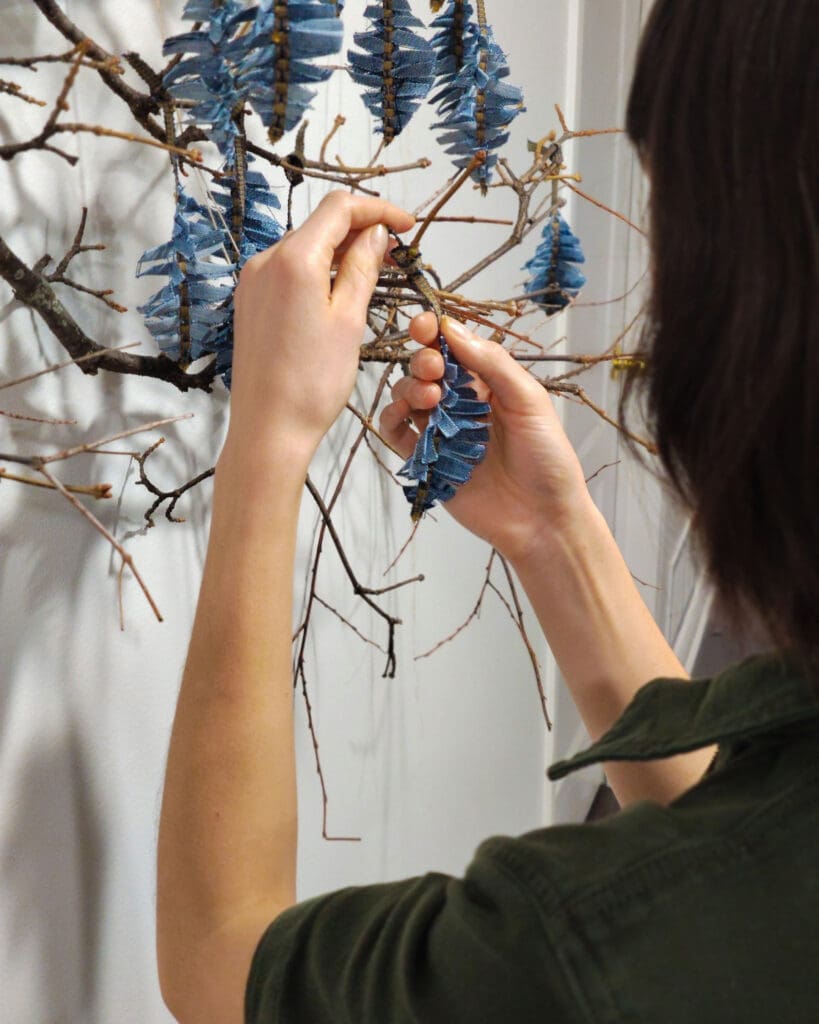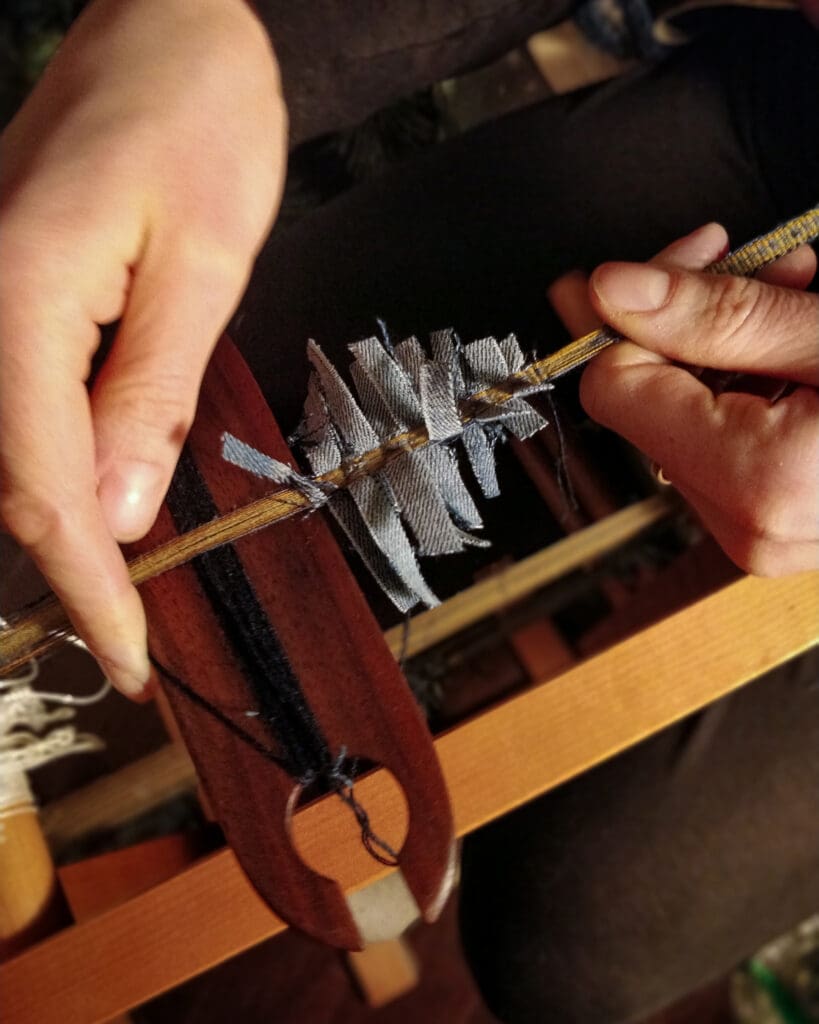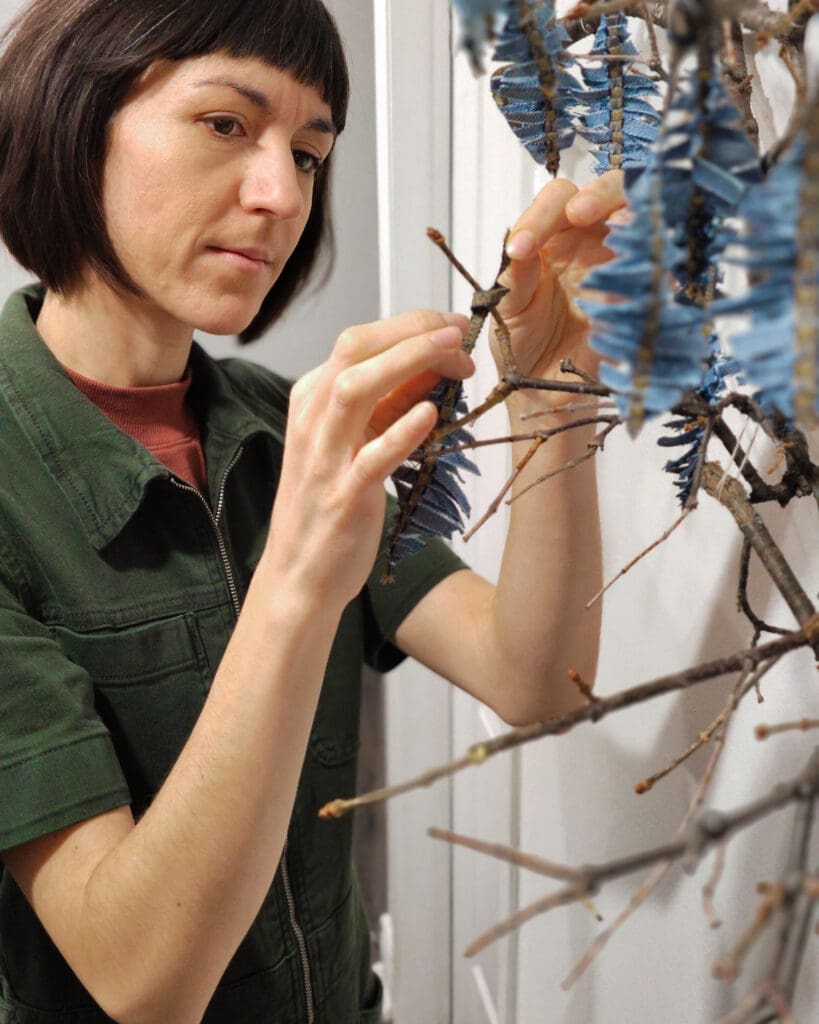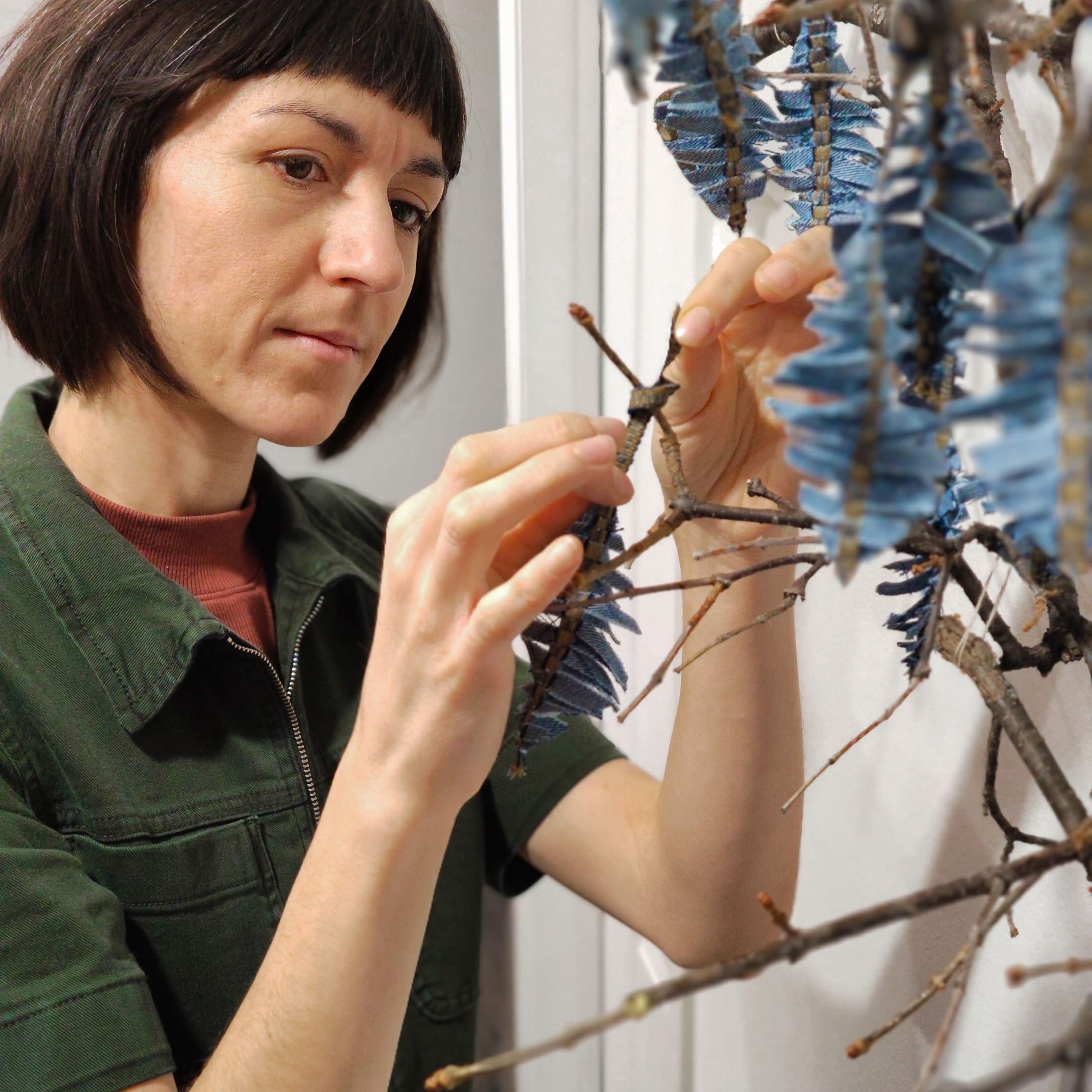Meet Ruth Wickremesooriya, the visionary artist behind Let’s Be Honest, a stunning denim installation featured at DUER’s Ossington storefront during DesignTO, which is on from January 24 to Febraury 2. Through deconstructed jeans and creative reuse, Ruth crafts a powerful statement on sustainability and self-reflection. We caught up with her to discuss her process, inspiration, and how this collaboration brings art and design to life. —Noa Nichol



What inspired the concept behind your installation, “Let’s Be Honest”? Can you share how the idea of denim “leaves” and the act of releasing disappointments came to life?
“Let’s Be Honest’ is a new piece made especially for DesignTO using salvaged DUER denim from the Ossington Store.
The themes and imagery are rooted in a series of poems I have been working on this year that explore how winter trees can teach us to endure long seasons of waiting with hope. When we started collaborating for the festival, I saw a wonderful opportunity to express some of those themes in a tactile and embodied way, and it seemed the natural choice to use discarded denim from the DUER store as the primary medium for that. I deconstructed each pair of jeans and re-wove the fabric into hundreds of denim ‘leaves’ that are suspended in the window.
The invitation of the piece is to be honest about those hidden disappointments that burden us and can push us towards hopelessness or despair. Visitors are encouraged to remove a leaf from the tree and place it on the ground as an embodied symbol of releasing unhealthy expectations of themselves or others. Just like fallen leaves decompose and nourish the ground, sometimes our expectations need to ‘die’ to enable new life to grow.
Denim is a central element in your work. Why did you choose this material, and how does it align with your artistic vision?
A simple reason is that the denim palette resonates with me deeply – I love the indigo with rusty brown and gold details! This is a very wintery palette for me, and one that resonates with the themes of my work. Denim is also one of the most ubiquitous fabrics on the planet, and because of that is also one of the most concerning in the environmental impact of its production, use and disposal. By working with discarded or salvaged denim, it is my small way of reclaiming the beauty of this material.
What does the collaboration with DUER mean to you? How do you see their brand values resonating with your artistic themes?
Collaborating with DUER was in many ways an obvious fit because we share so many common goals and values; a love of denim and natural materials, a responsibility to care for the earth, a desire to create something of beauty and use that lasts beyond trends and seasons. It’s so refreshing to work with people who are putting energy into innovating a more sustainable society.
Your work explores themes of brokenness, hope, and transformation. How do these ideas manifest in “Let’s Be Honest” and the broader “Winter Waiting” exhibition?
For me, the making process itself is a huge expression of these themes. By attempting to literally weave value into waste, the materials I am using get transformed from something ‘worthless’ or ‘unusable’ to something of beauty and value again.
The work is also very personal, emerging from my own ongoing struggles with depression, anxiety and perfectionism – my own brokenness. The piece ‘Let’s Be Honest’ flows out of the realisation that when we allow our unrealistic expectations and disappointments to fall away and break down, like autumn leaves in the soil, what is left behind is bare honesty that – while vulnerable – can actually lead to hopeful change, even if it is small and incremental.
Sustainability is a recurring theme in your work. How do you approach creative reuse, and what message do you hope to convey about sustainability through this installation?
My goal with my studio practice is to reach a point where I am consuming no virgin materials to create my work. Each handwoven piece is made using discarded textiles, and any inevitable studio waste generated in the weaving process is gathered to become raw material for handmade papers, which have become the canvas for poetry. The paper is pigmented with charcoal which I also made from my studio fabric waste. This process is a living metaphor of transformation and circularity, which is so necessary for us as human beings as well as the ways we care for the earth.
Can you tell us about the process of deconstructing DUER jeans to create the handwoven denim “leaves”? How long did it take, and what challenges did you face?
It took a very long time! I literally unpicked all the seams of the jeans and kept as many threads intact as possible to use as the warp (vertical threads) for the denim ‘leaves’. The weft (horizontal threads) are made from hand cut strips of denim fabric. The challenge I always face is that I underestimate this stage of the process and minimise its value because I want to get to the weaving stage, which feels more ‘productive’. But it’s a valuable process for me to learn how to slow down and readjust my expectations.
How does the interactive nature of this installation enhance the viewer’s experience and connection to the artwork?
I think our current cultural moment gives us a lot of opportunities to consume or observe from a distance. This means it’s really easy to move through life without engaging with our underlying fears and emotions, because we can so easily find distraction. By making the installation interactive, I hope to offer an invitation to participate in something larger than our individual selves, recognise the commonality of our struggles, and create a moment of reflection that could move visitors towards hope and healing.
As part of DesignTO, your work will be seen by a diverse audience. What do you hope visitors take away from your installation?
My sincere hope for my artwork is that it can provide a small space for reflection and stillness in the midst of a world that struggles to slow down. My experience is that the pace of modern life makes it so easy to rush past our hard emotions or push ourselves to keep doing more. I think we as humans need our own ‘winter times’ where we stop moving long enough to face the hard things in and around us, and learn to move through them with a more resilient hope.
Your artistic practice emphasizes slow, deliberate creation as a response to throwaway culture. How has this philosophy influenced your approach to this project?
The main reason my artistic practice emphasises slowness is because I recognise its value but struggle to accept it in other areas of my life. I am learning (slowly and messily) that the answer to making something meaningful is not always “do more, work harder”. For this project, for example, I initially wanted to weave many hundreds of leaves as well as a large, abstract tree trunk. Part of making the work authentically has been processing my own expectations for the work and adjusting them based on my limitations, so that what I show is good – but not at the unnecessary expense of healthy rest and time with my family.
Looking ahead, what’s next for you? Are there any upcoming projects or collaborations we should watch out for?
Right now I am in a busy teaching season, so my art creation is having its own winter time! But I am working on some collaborative projects and funding applications to develop these concepts further. I am really interested in exploring how my work can directly facilitate mental health healing and authentic conversations about our disappointments. There are a number of things I can’t talk about yet but the best way to stay up to date is to follow along on Instagram or join my email list for updates!
Win! A $300 DU/ER Gift Card!
Congrats Winnie W. of Coquitlam, BC, who will receive a $300 DU/ER Gift Card! Please note: if you are the winner, you will receive a DM (direct message) in Instagram directly from @vitadailymedia. Please be wary of fake accounts, which often use similar handles with an extra or missing letter, number or symbol. We will never ask for a payment or for your credit card number, and we will never ask you to click through a link. If you are unsure whether you have been contacted, via Instagram, by us or a fake account, email us before responding.

January 24th, 2025 at 9:39 am
Louise Smith loves art
Anthony Smith on FB
January 24th, 2025 at 10:22 am
Craig Reed loves art @cor.reed
January 24th, 2025 at 2:48 pm
My sister Taylor loves art.
Nolan Smith (Facebook)
January 24th, 2025 at 5:41 pm
Kam loves cool designs like this @jan_leeu
January 25th, 2025 at 11:56 am
@prepcookandeat loves her denim!! @janinerutledge
January 25th, 2025 at 11:57 am
My friend @prepcookandeat loves her denim! @janinerutledge
January 25th, 2025 at 1:16 pm
My friend Jen (@bluecanoe456) – really loves art and design.
@msdanieli
January 25th, 2025 at 5:10 pm
My friend @debfifi love art.
January 25th, 2025 at 10:47 pm
@amira_and_amir Loves art
@marilyn_kaluza
January 26th, 2025 at 8:55 am
My daughter loves art
@pnina44
January 27th, 2025 at 12:55 pm
My friend Odette LOOOOOVES art
January 28th, 2025 at 5:53 pm
My daughter Janet is an artist and art lover. On ig lillianmb23
January 29th, 2025 at 7:34 pm
@gerberadaisy loves art and design.
IG @minty_mo2020
January 29th, 2025 at 11:16 pm
@agee1004 lives art & design!
I’m @ccuma
January 30th, 2025 at 8:29 am
My friend @hdfraga loves her art and design! Thanks @maryandcedar
January 31st, 2025 at 9:01 pm
@chrismiles loves art and design! Thanks. @xuliang889